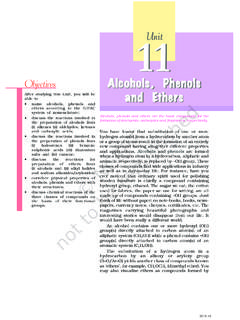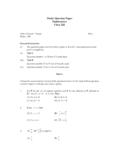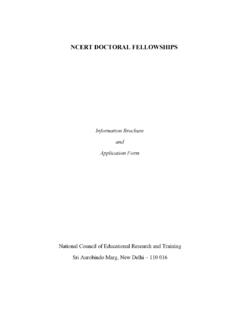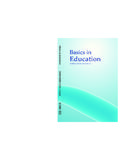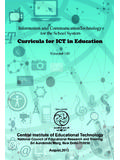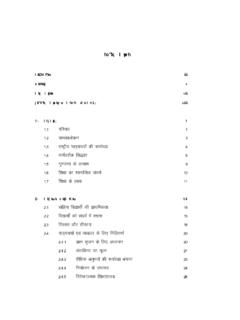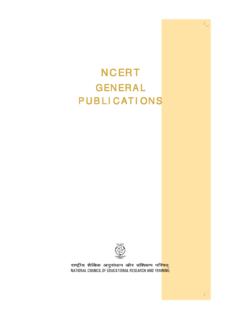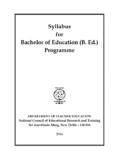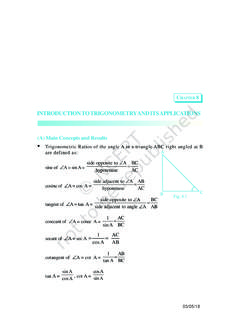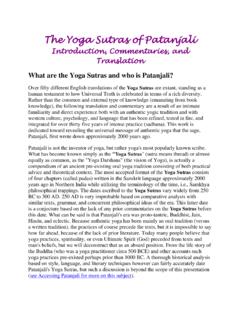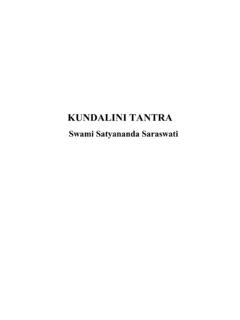Transcription of SOME BASIC CONCEPTS OF CHEMISTRY
1 UNIT 1 SOME BASIC CONCEPTS OF CHEMISTRYC hemistry is the science of molecules and theirtransformations. It is the science not so much of the onehundred elements but of the infinite variety of molecules thatmay be built from HoffmannScience can be viewed as a continuing human effort tosystematise knowledge for describing and understandingnature. You have learnt in your previous classes that we comeacross diverse substances present in nature and changes inthem in daily life. Curd formation from milk, formation ofvinegar from sugarcane juice on keeping for prolonged timeand rusting of iron are some of the examples of changes whichwe come across many times. For the sake of convenience,science is sub-divided into various disciplines: CHEMISTRY ,physics, biology, geology, etc. The branch of science thatstudies the preparation, properties, structure and reactionsof material substances is called OF CHEMISTRYC hemistry, as we understand it today, is not a very olddiscipline.
2 CHEMISTRY was not studied for its own sake, ratherit came up as a result of search for two interesting things:i. Philosopher s stone (Paras) which would convert all baser metals , iron and copper into Elexir of life which would grant in ancient India, already had the knowledge of manyscientific phenomenon much before the advent of modernscience. They applied that knowledge in various walks oflife. CHEMISTRY developed mainly in the form of Alchemyand Iatrochemistry during 1300-1600 CE. Modernchemistry took shape in the 18th century Europe, after afew centuries of alchemical traditions which wereintroduced in Europe by the studying this unit, you will beable to appreciate the contribution ofIndia in the development ofchemistry understand the role ofchemistry in different spheres oflife; explain the characteristics ofthree states of matter; classify different substances intoelements, compounds andmixtures; use scientific notations anddetermine significant figures; differentiate between precision andaccuracy; define SI base units and convertphysical quantities from onesystem of units to another; explain various laws of chemicalcombination; appreciate significance of atomicmass, average atomic mass,molecular mass and formulamass; describe the terms mole andmolar mass.
3 Calculate the mass per cent ofcomponent elements constitutinga compound; determine empirical formula andmolecular formula for a compoundfrom the given experimental data;and perform the cultures especially the Chinese andthe Indian had their own alchemical included much knowledge of chemicalprocesses and ancient India, CHEMISTRY was calledRasayan Shastra, Rastantra, Ras kriya orRasvidya. It included metallurgy, medicine,manufacture of cosmetics, glass, dyes, excavations at Mohenjodaro inSindh and Harappa in Punjab prove that thestory of development of CHEMISTRY in India isvery old. Archaeological findings show thatbaked bricks were used in construction shows the mass production of pottery, whichcan be regarded as the earliest chemical process,in which materials were mixed, moulded andsubjected to heat by using fire to achievedesirable qualities. Remains of glazed potteryhave been found in Mohenjodaro.
4 Gypsumcement has been used in the construction contains lime, sand and traces of made faience, a sort of glass whichwas used in ornaments. They melted and forgeda variety of objects from metals, such as lead,silver, gold and copper. They improved thehardness of copper for making artefacts byusing tin and arsenic. A number of glass objectswere found in Maski in South India (1000 900 BCE), and Hastinapur and Taxila in NorthIndia (1000 200 BCE). Glass and glazes werecoloured by addition of colouring agents likemetal metallurgy in India dates back tothe beginning of chalcolithic cultures in thesubcontinent. There are much archeologicalevidences to support the view that technologiesfor extraction of copper and iron were to Rigveda, tanning of leatherand dying of cotton were practised during1000 400 BCE. The golden gloss of the blackpolished ware of northen India could not bereplicated and is still a chemical mystery.
5 Thesewares indicate the mastery with which kilntemperatures could be controlled. Kautilya sArthashastra describes the production of saltfrom vast number of statements and materialdescribed in the ancient Vedic literature canbe shown to agree with modern scientificfindings. Copper utensils, iron, gold, silverornaments and terracotta discs and paintedgrey pottery have been found in manyarchaeological sites in north India. SushrutaSamhita explains the importance of Charaka Samhita mentions ancientindians who knew how to prepare sulphuricacid, nitric acid and oxides of copper, tin andzinc; the sulphates of copper, zinc and iron andthe carbonates of lead and describes the preparationof gunpowder mixture. Tamil texts alsodescribe the preparation of fireworks usingsulphur, charcoal, saltpetre ( , potassiumnitrate), mercury, camphor, was a great Indian scientist. Hewas a reputed chemist, an alchemist and ametallurgist.
6 His work Rasratnakar deals withthe formulation of mercury compounds. He hasalso discussed methods for the extraction ofmetals, like gold, silver, tin and copper. A book,Rsarnavam, appeared around 800 CE. Itdiscusses the uses of various furnaces, ovensand crucibles for different purposes. Itdescribes methods by which metals could beidentified by flame discovered mercury credit for inventing soap also goes to used mustard oil and some alkalies asingredients for making soap. Indians beganmaking soaps in the 18th century CE. Oil ofEranda and seeds of Mahua plant and calciumcarbonate were used for making paintings found on the walls of Ajantaand Ellora, which look fresh even after ages,testify to a high level of science achieved inancient India. Var hmihir s Brihat Samhita isa sort of encyclopaedia, which was composedin the sixth century CE. It informs about thepreparation of glutinous material to be appliedon walls and roofs of houses and temples.
7 Itwas prepared entirely from extracts of variousplants, fruits, seeds and barks, which wereconcentrated by boiling, and then, treated withvarious resins. It will be interesting to test suchmaterials scientifically and assess them for BASIC CONCEPTS OF CHEMISTRYA number of classical texts, likeAtharvaveda (1000 BCE) mention some dyestuff, the material used were turmeric, madder,sunflower, orpiment, cochineal and lac. Someother substances having tinting property werekamplcica, pattanga and hmihir s Brihat Samhita givesreferences to perfumes and cosmetics. Recipesfor hair dying were made from plants, likeindigo and minerals like iron power, black ironor steel and acidic extracts of sour rice describes recipes for makingscents, mouth perfumes, bath powders,incense and talcum was known to India in the17th century as account of Chinese travellerI-tsing describes. Excavations at Taxila indicatethat ink was used in India from the fourthcentury.
8 Colours of ink were made from chalk,red lead and seems that the process of fermentationwas well-known to Indians. Vedas andKautilya s Arthashastra mention about manytypes of liquors. Charaka Samhita alsomentions ingredients, such as barks of plants,stem, flowers, leaves, woods, cereals, fruits andsugarcane for making concept that matter is ultimately madeof indivisible building blocks, appeared inIndia a few centuries BCE as a part ofphilosophical speculations. Acharya Kanda,born in 600 BCE, originally known by thename Kashyap, was the first proponent of the atomic theory . He formulated the theory ofvery small indivisible particles, which henamed Param nu (comparable to atoms). Heauthored the text Vaiseshika to him, all substances areaggregated form of smaller units called atoms(Param nu), which are eternal, indestructible,spherical, suprasensible and in motion in theoriginal state. He explained that this individualentity cannot be sensed through any humanorgan.
9 Kanda added that there are varieties ofatoms that are as different as the differentclasses of substances. He said these(Param nu) could form pairs or triplets, amongother combinations and unseen forces causeinteraction between them. He conceptualisedthis theory around 2500 years before JohnDalton (1766-1844).Charaka Samhita is the oldest Ayurvedicepic of India. It describes the treatment ofdiseases. The concept of reduction of particlesize of metals is clearly discussed in CharakaSamhita. Extreme reduction of particle size istermed as nanotechnology. Charaka Samhitadescribes the use of bhasma of metals in thetreatment of ailments. Now-a-days, it has beenproved that bhasmas have nanoparticles the decline of alchemy, Iatrochemistryreached a steady state, but it too declined dueto the introduction and practise of westernmedicinal system in the 20th century. Duringthis period of stagnation, pharmaceuticalindustry based on Ayurveda continued toexist, but it too declined gradually.
10 It tookabout 100-150 years for Indians to learn andadopt new techniques. During this time, foreignproducts poured in. As a result, indigenoustraditional techniques gradually science appeared in Indian scene inthe later part of the nineteenth century. By themid-nineteenth century, European scientistsstarted coming to India and modern chemistrystarted the above discussion, you have learntthat CHEMISTRY deals with the composition,structure, properties and interection of matterand is of much use to human beings in dailylife. These aspects can be best described andunderstood in terms of BASIC constituents ofmatter that are atoms and molecules. Thatis why, CHEMISTRY is also called the science ofatoms and molecules. Can we see, weigh andperceive these entities (atoms and molecules)?Is it possible to count the number of atomsand molecules in a given mass of matter andhave a quantitative relationship between themass and the number of these particles?
